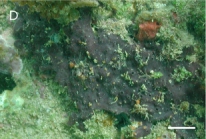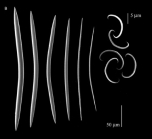 |
 |
|
|
||
Porifera taxon detailsXestospongia bocatorensis Díaz, Thacker, Rützler & Piantoni, 2007
255054 (urn:lsid:marinespecies.org:taxname:255054)
accepted
Species
marine,
recent only
Díaz, M.C.; Thacker, R.W.; Rützler, K.; Piantoni, C. (2007). Two new haplosclerid sponges from Caribbean Panama with symbiotic filamentous cyanobacteria, and an overview of sponge-cyanobacteria associations.<i> In</i>: Custódio MR, Lôbo-Hajdu G, Hajdu E, Muricy G (eds) Porifera Research. Biodiversity, Innovation and Sustainability. Livros de Museu Nacional 28, Rio de Janeiro, pp 31-39.
page(s): 36-37 [details] Available for editors
Holotype USNM 1106222, geounit Southwestern Caribbean
Holotype USNM 1106222, geounit Southwestern Caribbean [details]
Description Shape and size: Thinly encrusting species (2-5 mm thick),in
patches from five to a few hundred cm2. Surface: Smooth....
Description Shape and size: Thinly encrusting species (2-5 mm thick),in patches from five to a few hundred cm2. Surface: Smooth. Oscules (1-2 mm diameter) on top of low volcano-shaped mounds (1-2 mm of height). Consistency: Crumbly and brittle. Colour: In live, dark purple, inside and out. Cream to white in alcohol. Ectosomal skeleton: No organization, spicules strewn tangentially. Choanosomal skeleton: Isotropic unispicular to paucispicular reticulation forming polygonal meshes (100-320 ¼m in diameter), and paucispicular primaries (2-3 spicules across) 200-300 ¼m apart. Filamentous cyanobacteria densely packed around the skeleton. Spicules: Fusiform to slightly hastate stout oxeas in one size class (230-320 x 8-15 ¼m), with pointed ends. Sigmas, c-shaped (10-26 x <1 ¼m). Ecology: The species was found growing in small patches on mangrove roots, empty shells, or coral rubble, and occasionally profusely overgrowing live corals. Also found on shallow reefs (0-15 m deep) growing over coral and bare rock substrates. [details]
de Voogd, N.J.; Alvarez, B.; Boury-Esnault, N.; Cárdenas, P.; Díaz, M.-C.; Dohrmann, M.; Downey, R.; Goodwin, C.; Hajdu, E.; Hooper, J.N.A.; Kelly, M.; Klautau, M.; Lim, S.C.; Manconi, R.; Morrow, C.; Pinheiro, U.; Pisera, A.B.; Ríos, P.; Rützler, K.; Schönberg, C.; Turner, T.; Vacelet, J.; van Soest, R.W.M.; Xavier, J. (2024). World Porifera Database. Xestospongia bocatorensis Díaz, Thacker, Rützler & Piantoni, 2007. Accessed at: https://www.marinespecies.org/porifera/porifera.php?p=taxdetails&id=255054 on 2024-04-19
Date action by
original description
Díaz, M.C.; Thacker, R.W.; Rützler, K.; Piantoni, C. (2007). Two new haplosclerid sponges from Caribbean Panama with symbiotic filamentous cyanobacteria, and an overview of sponge-cyanobacteria associations.<i> In</i>: Custódio MR, Lôbo-Hajdu G, Hajdu E, Muricy G (eds) Porifera Research. Biodiversity, Innovation and Sustainability. Livros de Museu Nacional 28, Rio de Janeiro, pp 31-39.
page(s): 36-37 [details] Available for editors  Present Present  Inaccurate Inaccurate  Introduced: alien Introduced: alien  Containing type locality Containing type locality
Holotype USNM 1106222, geounit Southwestern Caribbean [details]
From editor or global species database
Description Shape and size: Thinly encrusting species (2-5 mm thick),inpatches from five to a few hundred cm2. Surface: Smooth. Oscules (1-2 mm diameter) on top of low volcano-shaped mounds (1-2 mm of height). Consistency: Crumbly and brittle. Colour: In live, dark purple, inside and out. Cream to white in alcohol. Ectosomal skeleton: No organization, spicules strewn tangentially. Choanosomal skeleton: Isotropic unispicular to paucispicular reticulation forming polygonal meshes (100-320 ¼m in diameter), and paucispicular primaries (2-3 spicules across) 200-300 ¼m apart. Filamentous cyanobacteria densely packed around the skeleton. Spicules: Fusiform to slightly hastate stout oxeas in one size class (230-320 x 8-15 ¼m), with pointed ends. Sigmas, c-shaped (10-26 x <1 ¼m). Ecology: The species was found growing in small patches on mangrove roots, empty shells, or coral rubble, and occasionally profusely overgrowing live corals. Also found on shallow reefs (0-15 m deep) growing over coral and bare rock substrates. [details] |

